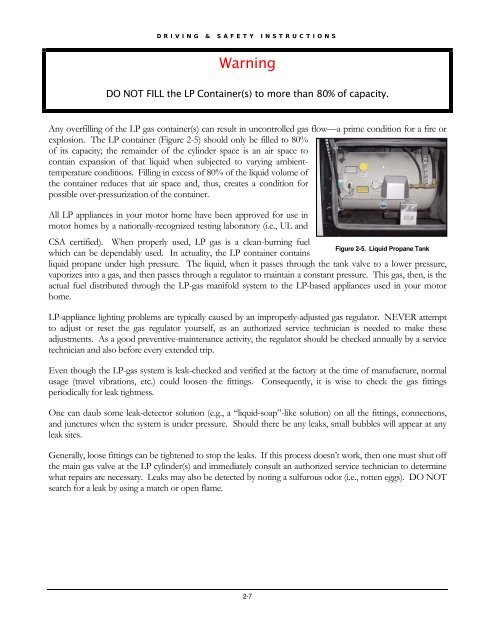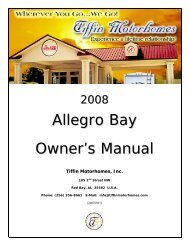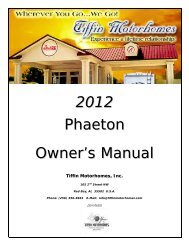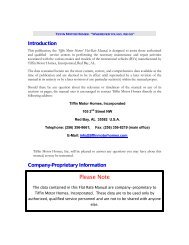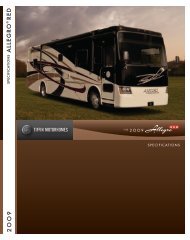Phaeton Owner's Manual - Tiffin Motorhomes | Wherever You
Phaeton Owner's Manual - Tiffin Motorhomes | Wherever You
Phaeton Owner's Manual - Tiffin Motorhomes | Wherever You
- No tags were found...
Create successful ePaper yourself
Turn your PDF publications into a flip-book with our unique Google optimized e-Paper software.
DRIVING & SAFETY INSTRUCTIONSWarningDO NOT FILL the LP Container(s) to more than 80% of capacity.Any overfilling of the LP gas container(s) can result in uncontrolled gas flow—a prime condition for a fire orexplosion. The LP container (Figure 2-5) should only be filled to 80%of its capacity; the remainder of the cylinder space is an air space tocontain expansion of that liquid when subjected to varying ambienttemperatureconditions. Filling in excess of 80% of the liquid volume ofthe container reduces that air space and, thus, creates a condition forpossible over-pressurization of the container.All LP appliances in your motor home have been approved for use inmotor homes by a nationally-recognized testing laboratory (i.e., UL andCSA certified). When properly used, LP gas is a clean-burning fuelFigure 2-5. Liquid Propane Tankwhich can be dependably used. In actuality, the LP container containsliquid propane under high pressure. The liquid, when it passes through the tank valve to a lower pressure,vaporizes into a gas, and then passes through a regulator to maintain a constant pressure. This gas, then, is theactual fuel distributed through the LP-gas manifold system to the LP-based appliances used in your motorhome.LP-appliance lighting problems are typically caused by an improperly-adjusted gas regulator. NEVER attemptto adjust or reset the gas regulator yourself, as an authorized service technician is needed to make theseadjustments. As a good preventive-maintenance activity, the regulator should be checked annually by a servicetechnician and also before every extended trip.Even though the LP-gas system is leak-checked and verified at the factory at the time of manufacture, normalusage (travel vibrations, etc.) could loosen the fittings. Consequently, it is wise to check the gas fittingsperiodically for leak tightness.One can daub some leak-detector solution (e.g., a “liquid-soap”-like solution) on all the fittings, connections,and junctures when the system is under pressure. Should there be any leaks, small bubbles will appear at anyleak sites.Generally, loose fittings can be tightened to stop the leaks. If this process doesn’t work, then one must shut offthe main gas valve at the LP cylinder(s) and immediately consult an authorized service technician to determinewhat repairs are necessary. Leaks may also be detected by noting a sulfurous odor (i.e., rotten eggs). DO NOTsearch for a leak by using a match or open flame.2-7


